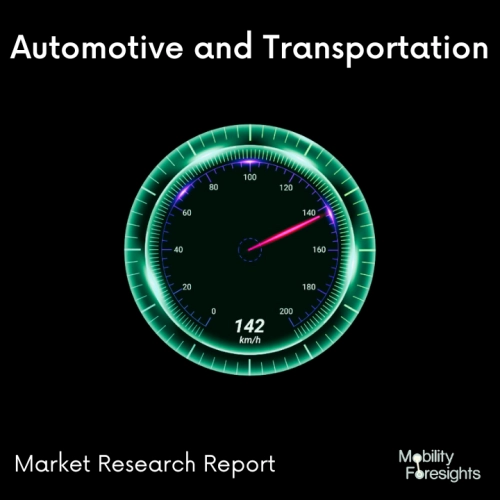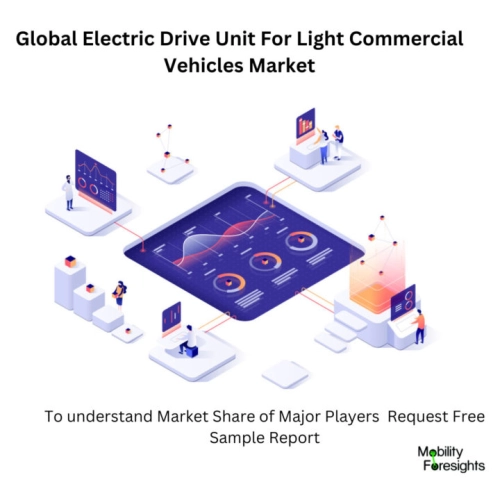
- Get in Touch with Us

Last Updated: Apr 25, 2025 | Study Period: 2023-2030
The device that transforms electrical energy from the vehicle's battery into mechanical power to drive the wheels is known as the Electric Drive Unit (EDU) in light commercial vehicles (LCVs). It is made up of a number of parts that combine to give LCVs with effective and dependable propulsion.
Usually, the following are the primary parts of an electric drive unit for LCVs:
The main element in charge of transforming electrical energy into mechanical power is the electric motor. Depending on the architecture of the vehicle, it is often either an AC (alternating current) or DC (direct current) motor. The vehicle is propelled by the rotational force produced by the motor.
Electric energy is transferred from the battery pack to the electric motor under the supervision of the power electronics module. To effectively manage power delivery to the motor, it is made up of parts like inverters, converters, and controllers that control voltage, current, and frequency.
Depending on the architecture of the vehicle, the electric drive unit may employ direct drive or a gearbox arrangement. To maximize performance and efficiency, certain LCVs may have single-speed gearboxes while others may have multi-speed transmissions.
Battery Pack: The electric drive unit is powered by a battery pack, which stores electrical energy. To supply the necessary voltage and capacity, it often consists of many battery cells coupled together. Regenerative braking or an external power source can be used to recharge the rechargeable battery pack.
Electric drive units produce heat while in use, so a cooling system is necessary to maintain ideal temperatures, assure longevity, and maximize the performance of the components. For the purpose of dissipating heat from the electric motor and power electronics, this system could contain radiators, pumps, and fans.
Control systems: A number of control systems oversee how the electric drive unit functions as a whole. These technologies, which optimize energy usage and offer a comfortable driving experience, include motor controllers, regenerative braking systems, traction control, and other software algorithms.
Compared to conventional internal combustion engines, the electric drive unit in LCVs has a number of benefits, including lower running costs, higher efficiency, and lower emissions. Electric drive units are becoming more prevalent in light commercial vehicles as a sustainable and practical alternative to conventional powertrains as electric vehicle technology continues to progress

The Global Electric Drive Unit For Light Commercial Vehicles Market accounted for $XX Billion in 2022 and is anticipated to reach $XX Billion by 2030, registering a CAGR of XX% from 2023 to 2030.
A new compact electric drive module from Bosch makes its premiere at Daimler Truck for light commercial vehicles. A new drive unit for light commercial vehicles from Bosch is already in serial production. It consists of an electric motor and an integrated inverter. The high-voltage battery is connected to the inverter, which also controls the electric motor.
The motor and inverter weigh about 80 kilograms when combined. By using innovative power semiconductors to cut electrical losses by more than 20%, Bosch was able to achieve an inverter efficiency level of 97%, extending the driving range of the vehicles.
The drive module may now be integrated into both current and future car models even more easily thanks to the flexible architecture.
| Sl no | Topic |
| 1 | Market Segmentation |
| 2 | Scope of the report |
| 3 | Abbreviations |
| 4 | Research Methodology |
| 5 | Executive Summary |
| 6 | Introduction |
| 7 | Insights from Industry stakeholders |
| 8 | Cost breakdown of Product by sub-components and average profit margin |
| 9 | Disruptive innovation in the Industry |
| 10 | Technology trends in the Industry |
| 11 | Consumer trends in the industry |
| 12 | Recent Production Milestones |
| 13 | Component Manufacturing in US, EU and China |
| 14 | COVID-19 impact on overall market |
| 15 | COVID-19 impact on Production of components |
| 16 | COVID-19 impact on Point of sale |
| 17 | Market Segmentation, Dynamics and Forecast by Geography, 2023-2030 |
| 18 | Market Segmentation, Dynamics and Forecast by Product Type, 2023-2030 |
| 19 | Market Segmentation, Dynamics and Forecast by Application, 2023-2030 |
| 20 | Market Segmentation, Dynamics and Forecast by End use, 2023-2030 |
| 21 | Product installation rate by OEM, 2023 |
| 22 | Incline/Decline in Average B-2-B selling price in past 5 years |
| 23 | Competition from substitute products |
| 24 | Gross margin and average profitability of suppliers |
| 25 | New product development in past 12 months |
| 26 | M&A in past 12 months |
| 27 | Growth strategy of leading players |
| 28 | Market share of vendors, 2023 |
| 29 | Company Profiles |
| 30 | Unmet needs and opportunity for new suppliers |
| 31 | Conclusion |
| 32 | Appendix |